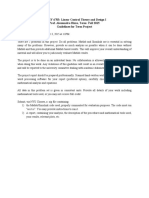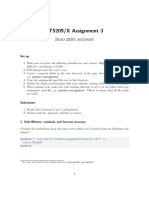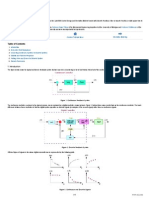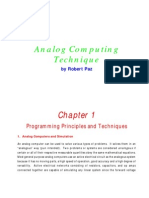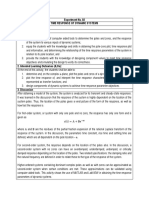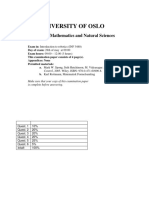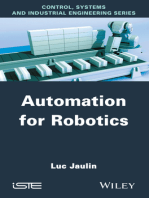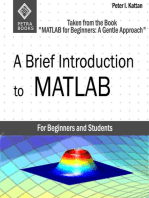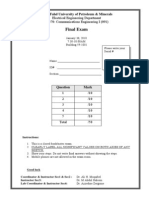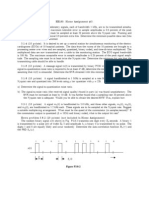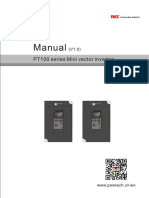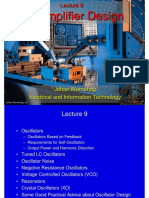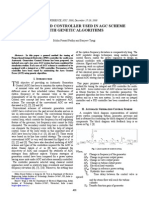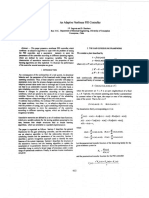EE132 Lab1 OL Vs CL
EE132 Lab1 OL Vs CL
Uploaded by
thinkberry22Copyright:
Available Formats
EE132 Lab1 OL Vs CL
EE132 Lab1 OL Vs CL
Uploaded by
thinkberry22Original Description:
Original Title
Copyright
Available Formats
Share this document
Did you find this document useful?
Is this content inappropriate?
Copyright:
Available Formats
EE132 Lab1 OL Vs CL
EE132 Lab1 OL Vs CL
Uploaded by
thinkberry22Copyright:
Available Formats
1
EE 132 Lab 1: Open vs Closed Loop
I. OBJECTIVE
To compare the performance of open and closed loop controllers, applied to a simple plant, in the presence of
disturbances or modeling error.
II. EQUIPMENT
Matlab and Simulink
III. BACKGROUND
Consider a DC motor shown in Fig. 1. The schematic diagram for this system is shown in Fig. 2, where R is the
electric resistance, L is the electric inductance, is the angle of the shaft, =
is the angular rate of the shaft, T
is the motor torque, V is the input voltage, J is the moment of inertia of the rotor, b is the coefcient of friction
of the mechanical system. For a DC motor, we have the following relations
T = Ki (1)
e = K (2)
where i is the armature current, e is the back electromotive force, and K is the electromotive force constant. Let
d(t) represent an unknown load torque applied to the shaft. For example, if this is a grinding application, then the
torque d would be determined by the force applied to the grinding disk by the user.
The state space model of this system is
J + b = Ki + d (3)
L
di
dt
+ Ri = V K (4)
From (4), we have
i =
L
R
di
dt
+
V
R
K
R
.
We will assume that the motor has been selected such that R >> L, then L/R 0 and
i =
V
R
K
R
.
Substitute i into (3), we have
J +
b +
K
2
R
=
K
R
V + d. (5)
Selecting the state variable as x = , equation (5) can be written as
x =
bR + K
2
JR
x +
K
JR
V +
1
J
d. (6)
If the nominal parameter values are as follows
b = 0.01N m s, J = 1.0 kg m
2
, K = 0.1
N m
A
, R = 1.0
then, equation (6) becomes
x = 0.02x + 0.1V + d. (7)
In (7), V is the control input, d can be considered as a disturbance, x is the angular velocity of the shaft. All units
in this lab are international units.
2
Fig. 1. DC motor Fig. 2. DC motor System
In practice, the nominal parameter values are not known exactly and may change with time. So, a more realistic
model than (7) is
x = (0.02 + a)x + (0.1 + b)V + d (8)
where a and b are uncertain constants terms.
For the prelab portion of this assignment, we will analyze the effects of a, b, and d.
For the in lab simulation portion of this assignment, we will only be concerned with the disturbance d.
System (7) is called the nominal system corresponding to (8). The nominal system can be obtained by letting
a = b = 0 in (8).
IV. PRELAB (COMPLETE THIS SECTION PRIOR TO LAB.)
In this section, we assume that the reference state x
c
(t) = 1u(t), where u(t) is a step function, i.e., u(t) = 1
for all t 0 and u(t) = 0 for all t < 0.
1) For system (7), design an open loop controller
V (t) = F
1
x
c
(t) (9)
where F
1
is a constant.
a) Find F
1
such that lim
t
(x(t) x
c
(t)) = 0 when d = 0, a = 0, and b = 0.
b) Where is the pole of the controlled system when d = a = b = 0? Is the pole location affected by the
choice of the control law parameter F
1
?
c) What is the settling time of the closed-loop system when d = a = b = 0 (i.e., three times the time
constant when d = a = b = 0)?
d) Find an expression for the tracking error x
e
= (x x
c
) as a function of d, a, and b.
2) For system (8), dene the closed loop controller
V (t) = P(x
c
(t) x(t)) + I
t
0
(x
c
() x())d (10)
where P and I are constant real numbers.
a) Substitute eqn. (10) int eqn. (7) with d = 0, transform to the frequency domain, and simplify, to nd
the closed loop transfer function from X
c
(s) to X(s).
b) Find P and I such that the closed loop transfer function from X
c
(s) to X(s) has poles at 0.1 j0.05
when d = a = b = 0.
3
i) To nd the desired characteristic equation (i.e., transfer function denominator), nd a polynomial
that has the specied roots.
ii) Find P and I so that the denominator of the closed loop transfer function matches the desired
characteristic equation.
c) What is the settling time of the closed-loop system when d = a = b = 0 (i.e., three times the 1/||,
where is the real portion of the pole when d = a = b = 0.)
d) What is the tracking error x
e
= (xx
c
) for constant values of d, a, and b, assuming the system remains
stable.
V. SIMULATION PROCEDURE
Please download the le Lab1.mdl from iLearn. Open the Simulink library in MATLAB. The simulation le
can be opened in the Simulink library. Finish the simulation implementation by the following steps.
1) The simulation implementation includes portions of the control law implementation. Check the implementation
of the plant model. Make sure that you agree, then proceed to the following steps.
2) Implement the open loop controller. Let x
c
be a step input at time zero with a magnitude of 1.0. Set the
length of the time interval to be 600 seconds for this case.
a) Simulate the response of system (8) with control law (9) when d = a = b = 0. In this step your goal is
to ensure that your prelab design and simulation implementation are correct (i.e., The steady state error
should be zero. Steady state should be approximately achieved in three time constants.)
b) Simulate the response of the open loop system for d = 0.1 and a = b = 0.
c) Show the results of the three simulations on one graph. Every time when you launch the Simulink le,
the time array and corresponding state array will be saved as Data in the workspace of MATLAB.
The time array can be obtained by using Data.time. The state array can be obtained by using
Data.signals.values. Then you can use your knowledge of MATLAB to plot what gure that is asked.
Ask the TA if you do not understand how to do this. Clearly label each graph. In your lab report, discuss
the effect of the off-nominal effects on the system response. Compare the simulated responses with the
prelab analysis.
d) Remove the open loop controller.
3) Implement the closed loop controller. Again, let x
c
be a step input at time zero with a magnitude of 1.0. Set
the length of the time interval to be 120 seconds for this case.
a) Simulate the response of system (8) with control law (10) when d = a = b = 0. In this step your goal
is to ensure that your prelab design and simulation implementation are correct (i.e., The steady state
error should be zero. Steady state should be approximately achieved in three time constants.)
b) Simulate the response of system (8) with control law (10) for d = 0.1 and a = b = 0.
c) Show the results of the three simulations on one graph. Ask the TA if you do not understand how to
do this. Clearly label each graph. In your lab report, discuss the effect of the off-nominal effects on the
system response. Compare the simulated responses with the prelab analysis.
Congratulations. You have implemented your rst closed loop control law. The simulation allows an easy means to
analyze the affect of changing the other model error terms. Investigate them if you are interested.
FIGURES - Throughout this class, all gures must be properly labeled
Each axis must have a variable name with units (e.g. tracking error, m/s).
The gure must have name (e.g., Figure 1).
Each gure must be mentioned by name and discussed in the text (e.g. Figure 1 shows that ...). The discussion
must state any conclusion that the students expects the reader to draw from the gure.
If a graph contains more than one curve, each curve should have a different line type. Each line type must
be dened. Each curve must be discussed. For example, Figure 1 shows that for d = 0.0 (solid curve) the
tracking error achieves a steady state value of ... in ... seconds and for d = 0.1 (dashed curve) the tracking
error achieves a steady state value of ... in ... seconds.
This direction will not be repeated in future labs, but is expected to be followed.
You might also like
- Mechatronics Electronic Control Systems in Mechanical and Electrical Engineering (Instructor Solution Manual, Solutions) (William Bolton) (Z-Library)Document65 pagesMechatronics Electronic Control Systems in Mechanical and Electrical Engineering (Instructor Solution Manual, Solutions) (William Bolton) (Z-Library)AlaaKhalifa100% (1)
- Introduction To Microelectronic FabricationDocument87 pagesIntroduction To Microelectronic FabricationBhushan Yadav81% (27)
- PDFDocument24 pagesPDFOlga Joy Labajo GerastaNo ratings yet
- Mechanical Vibration Lab ReportDocument7 pagesMechanical Vibration Lab ReportChris NichollsNo ratings yet
- Project Fall2015Document5 pagesProject Fall2015AlvinNo ratings yet
- ps3 (1) From MAE 4780Document5 pagesps3 (1) From MAE 4780fooz10No ratings yet
- Ee 5307 HomeworksDocument15 pagesEe 5307 HomeworksManoj KumarNo ratings yet
- Systems Control Laboratory: ECE557F LAB2: Controller Design Using Pole Placement and Full Order ObserversDocument6 pagesSystems Control Laboratory: ECE557F LAB2: Controller Design Using Pole Placement and Full Order ObserversColinSimNo ratings yet
- Poles Selection TheoryDocument6 pagesPoles Selection TheoryRao ZubairNo ratings yet
- Lab #2: PI Controller Design and Second Order SystemsDocument4 pagesLab #2: PI Controller Design and Second Order SystemssamielmadssiaNo ratings yet
- BIEN462 A1Document4 pagesBIEN462 A1Eileen FuNo ratings yet
- Discret IzationDocument18 pagesDiscret IzationsydofneeNo ratings yet
- Automatic Control III Homework Assignment 3 2015Document4 pagesAutomatic Control III Homework Assignment 3 2015salimNo ratings yet
- Lab # 8 Control SystemDocument10 pagesLab # 8 Control SystemZabeehullahmiakhailNo ratings yet
- Mfa Merit Exercises 5 Simulink 5174 2Document8 pagesMfa Merit Exercises 5 Simulink 5174 2JamesNo ratings yet
- Lab # 8 SolvedDocument10 pagesLab # 8 SolvedZabeehullahmiakhailNo ratings yet
- MCH3008 Project 1.1Document3 pagesMCH3008 Project 1.1hasanozcan55977No ratings yet
- EEN 407 Sample QuestionsDocument41 pagesEEN 407 Sample QuestionsAbu SiddiqueNo ratings yet
- Assignment3 Zhao ZihuiDocument8 pagesAssignment3 Zhao Zihuizhaozhaozizizi2No ratings yet
- ENGR 058 (Control Theory) Final: 1) Define The SystemDocument24 pagesENGR 058 (Control Theory) Final: 1) Define The SystemBizzleJohnNo ratings yet
- Labview GuideDocument8 pagesLabview GuideRameezNo ratings yet
- From Classical To State-Feedback-Based Controllers: Lecture NotesDocument10 pagesFrom Classical To State-Feedback-Based Controllers: Lecture Notesomarportillo123456No ratings yet
- Sample Solution To Exam in MAS501 Control Systems 2 Autumn 2015Document8 pagesSample Solution To Exam in MAS501 Control Systems 2 Autumn 2015Priyesh PandeyNo ratings yet
- Chapter 8: Introduction To Systems Control: 8.1 System Stability From Pole-Zero Locations (S-Domain)Document47 pagesChapter 8: Introduction To Systems Control: 8.1 System Stability From Pole-Zero Locations (S-Domain)Sreedharachary SimhaaNo ratings yet
- Enee 660 HW #7Document2 pagesEnee 660 HW #7PeacefulLion0% (1)
- Ex - Sloution CompendiumDocument115 pagesEx - Sloution CompendiumAli Jaber Al QattanNo ratings yet
- Matlab, Simulink - Control Systems Simulation Using Matlab and SimulinkDocument10 pagesMatlab, Simulink - Control Systems Simulation Using Matlab and SimulinkTarkes DoraNo ratings yet
- Signals Systems Lab 2Document5 pagesSignals Systems Lab 2ahmad.a.touseefNo ratings yet
- Tut I - IvDocument15 pagesTut I - Ivkabilans.mechanicalengineerNo ratings yet
- ENGM541 Lab5 Runge Kutta SimulinkstatespaceDocument5 pagesENGM541 Lab5 Runge Kutta SimulinkstatespaceAbiodun GbengaNo ratings yet
- Automatic Control ExerciseDocument140 pagesAutomatic Control Exercisetaile1995No ratings yet
- Control System 1st Mid Term Paper July Dec 2015Document17 pagesControl System 1st Mid Term Paper July Dec 2015VIPUL100% (2)
- TE 2019 MechatronicsDocument6 pagesTE 2019 MechatronicsVishalNo ratings yet
- NI Tutorial 6463 enDocument6 pagesNI Tutorial 6463 enAmaury BarronNo ratings yet
- Exercises in Nonlinear Control SystemsDocument99 pagesExercises in Nonlinear Control SystemsRiccardo M.G. Ferrari100% (2)
- Controls Problems For Qualifying Exam - Spring 2014: Problem 1Document11 pagesControls Problems For Qualifying Exam - Spring 2014: Problem 1MnshNo ratings yet
- HW 5Document2 pagesHW 5Mahir MahmoodNo ratings yet
- Control Systems PDFDocument24 pagesControl Systems PDFlum_78No ratings yet
- FEEDLAB 02 - System ModelsDocument8 pagesFEEDLAB 02 - System ModelsAnonymous DHJ8C3oNo ratings yet
- Exercises in Nonlinear Control SystemsDocument115 pagesExercises in Nonlinear Control SystemsAshk Nori ZadehNo ratings yet
- Control Systems Students PDFDocument23 pagesControl Systems Students PDFRocker byNo ratings yet
- Control Systems Students PDFDocument23 pagesControl Systems Students PDFRocker byNo ratings yet
- Analog Computer ManualDocument51 pagesAnalog Computer ManualYlver Prado YesquenNo ratings yet
- MATLAB - Programs On Control SystemDocument16 pagesMATLAB - Programs On Control SystemJay MehtaNo ratings yet
- Lab Ball Beam S08Document4 pagesLab Ball Beam S08Thiago CaetanoNo ratings yet
- Lab 06Document6 pagesLab 06CHEANG HOR PHENGNo ratings yet
- Modeling and Digital Simulation Case Studies: 3.1 Pre-Lab AssignmentDocument13 pagesModeling and Digital Simulation Case Studies: 3.1 Pre-Lab AssignmentLittle_skipNo ratings yet
- Control Systems LAB # 8 Design Via Root Locus: Example: Find The Root Locus For The T.F Matlab CodeDocument6 pagesControl Systems LAB # 8 Design Via Root Locus: Example: Find The Root Locus For The T.F Matlab CodeiyerrohitNo ratings yet
- Problem Set 5Document6 pagesProblem Set 5PeaceNo ratings yet
- Assignment 1 and 2Document7 pagesAssignment 1 and 2sahulipunku2001No ratings yet
- Lab3 v2Document10 pagesLab3 v2Pranshumaan SinghNo ratings yet
- Experiment 2Document16 pagesExperiment 2roxetteNo ratings yet
- CDS 110b Norms of Signals and SystemsDocument10 pagesCDS 110b Norms of Signals and SystemsSatyavir YadavNo ratings yet
- Opt Prob 10zDocument5 pagesOpt Prob 10zalejandro_ledesma_15No ratings yet
- Control SystemsDocument10 pagesControl SystemsSagaraptor RexNo ratings yet
- University of Oslo: Faculty of Mathematics and Natural SciencesDocument4 pagesUniversity of Oslo: Faculty of Mathematics and Natural Sciencesasalifew belachewNo ratings yet
- Student Solutions Manual to Accompany Economic Dynamics in Discrete Time, second editionFrom EverandStudent Solutions Manual to Accompany Economic Dynamics in Discrete Time, second editionRating: 4.5 out of 5 stars4.5/5 (2)
- Log-Linear Models, Extensions, and ApplicationsFrom EverandLog-Linear Models, Extensions, and ApplicationsAleksandr AravkinNo ratings yet
- Nonlinear Control Feedback Linearization Sliding Mode ControlFrom EverandNonlinear Control Feedback Linearization Sliding Mode ControlNo ratings yet
- A Brief Introduction to MATLAB: Taken From the Book "MATLAB for Beginners: A Gentle Approach"From EverandA Brief Introduction to MATLAB: Taken From the Book "MATLAB for Beginners: A Gentle Approach"Rating: 2.5 out of 5 stars2.5/5 (2)
- EE 141 Homework 8: (X (N) ) With K 0, 1,, N 1, Determine The Following ExpressionsDocument1 pageEE 141 Homework 8: (X (N) ) With K 0, 1,, N 1, Determine The Following Expressionsthinkberry22No ratings yet
- EE105 Lecture NotesDocument153 pagesEE105 Lecture Notesthinkberry22No ratings yet
- Lecture Notes: Jay A. Farrell, Professor College of Engineering University of California, Riverside February 10, 2014Document153 pagesLecture Notes: Jay A. Farrell, Professor College of Engineering University of California, Riverside February 10, 2014thinkberry22No ratings yet
- Menu CoronaDocument1 pageMenu Coronathinkberry22No ratings yet
- EE 105: MATLAB As An Engineer's Problem Solving ToolDocument3 pagesEE 105: MATLAB As An Engineer's Problem Solving Toolthinkberry22No ratings yet
- EE370 Final 091Document6 pagesEE370 Final 091thinkberry22No ratings yet
- Lecture Notes: Jay A. Farrell, Professor College of Engineering University of California, Riverside February 10, 2014Document153 pagesLecture Notes: Jay A. Farrell, Professor College of Engineering University of California, Riverside February 10, 2014thinkberry22No ratings yet
- Ee150hw04 2012Document2 pagesEe150hw04 2012thinkberry22No ratings yet
- Ee150hw01 2010Document2 pagesEe150hw01 2010thinkberry22100% (1)
- Ee150hw03 2012Document1 pageEe150hw03 2012thinkberry22No ratings yet
- Ee115hw+sol03 06 N PDFDocument6 pagesEe115hw+sol03 06 N PDFthinkberry22100% (1)
- Introducción PDFDocument14 pagesIntroducción PDFsalimNo ratings yet
- 1 - 303 - Feedwater Level Control SystemsDocument31 pages1 - 303 - Feedwater Level Control SystemsAnonymous 3fTYXaW7WNo ratings yet
- Analog Filter DesignDocument23 pagesAnalog Filter DesignKundan KumarNo ratings yet
- Powtech Pt100 ManualDocument112 pagesPowtech Pt100 ManualNisar AhmedNo ratings yet
- RF Amplifier Design: Johan Wernehag Electrical and Information TechnologyDocument23 pagesRF Amplifier Design: Johan Wernehag Electrical and Information TechnologyNabil DakhliNo ratings yet
- Supervisory Fuzzy Logic Controller Used For Process Loop ControlDocument6 pagesSupervisory Fuzzy Logic Controller Used For Process Loop ControlAndreNo ratings yet
- Robust Controller Design Using Multi-Objective Optimization Power Management DesignLineDocument5 pagesRobust Controller Design Using Multi-Objective Optimization Power Management DesignLineIvana PrezimeNo ratings yet
- Ratio Control For Pulp and Paper Consistency ControlDocument10 pagesRatio Control For Pulp and Paper Consistency ControlGauraw SharmaNo ratings yet
- 4th Sem B - Tech CSE SyllabusDocument6 pages4th Sem B - Tech CSE SyllabusPeter ParkerNo ratings yet
- Hespanha LSTDocument45 pagesHespanha LSTPARTHIB ROYNo ratings yet
- Tuning of Pid Controller Used in Agc Scheme With Genetic AlgorithmsDocument6 pagesTuning of Pid Controller Used in Agc Scheme With Genetic Algorithmsjjm_8679641No ratings yet
- Embedded Systems - An Introduction: Learning OutcomesDocument10 pagesEmbedded Systems - An Introduction: Learning Outcomessankar SNo ratings yet
- Shahid Project FinalDocument49 pagesShahid Project FinalPraveen MathiasNo ratings yet
- Power Control Techniques To Be Used in 3G (Wcdma)Document4 pagesPower Control Techniques To Be Used in 3G (Wcdma)Thuan TranNo ratings yet
- Author Biography:: System Dynamics/Systems Thinking: Let's Just Get On With ItDocument25 pagesAuthor Biography:: System Dynamics/Systems Thinking: Let's Just Get On With ItalltnNo ratings yet
- Laboratory Case Study: Control Systems - Root Locus Controller DesignDocument4 pagesLaboratory Case Study: Control Systems - Root Locus Controller DesigntiraNo ratings yet
- Protection of MV Closed-Loop Distribution NetworksDocument13 pagesProtection of MV Closed-Loop Distribution NetworksAkhilesh kumar SrivastavaNo ratings yet
- Anayo Ogazi Thesis 2011Document306 pagesAnayo Ogazi Thesis 2011Ton PhichitNo ratings yet
- 582 ProblemsDocument42 pages582 ProblemsBradley GrahamNo ratings yet
- Variadores de FrecDocument65 pagesVariadores de FrecFlavio Ramirez DoseNo ratings yet
- Electrical Engineering Department: M.Tech. Power SystemDocument29 pagesElectrical Engineering Department: M.Tech. Power Systemmathew thomasNo ratings yet
- An Adaptive Nonlinear Pid Controller PDFDocument5 pagesAn Adaptive Nonlinear Pid Controller PDFRodrigo ContrerasNo ratings yet
- Fundamentals of Cascade ControlDocument6 pagesFundamentals of Cascade ControlCyrix.One100% (1)
- 01.anatomy of A Feedback Control SystemDocument8 pages01.anatomy of A Feedback Control SystemMahesh GonuguntlaNo ratings yet
- RemezDocument3 pagesRemezmiindsurferNo ratings yet
- Brosur ACS 1000Document5 pagesBrosur ACS 1000Rina ManuhutuNo ratings yet
- Image Processing-Ch4 - Part 2Document47 pagesImage Processing-Ch4 - Part 2saifNo ratings yet
- Proceedings of PEEIACON 2024Document150 pagesProceedings of PEEIACON 2024mepixoy924No ratings yet
- 4504icbtme - Ics Assignment CDocument6 pages4504icbtme - Ics Assignment CKamal SurenNo ratings yet




